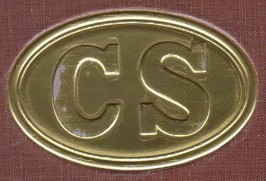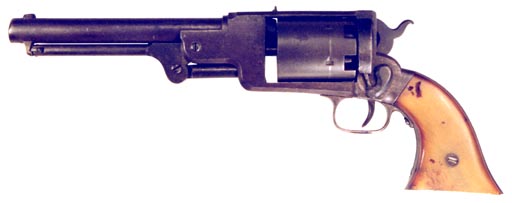

| Revolvers made in the Confederacy, however not on military contract |
THE MYSTERIOUS SISTERDALE REVOLVER
The rarest and less known of all Confederate revolvers is probably the gun of which only 6 were home made by the Dr Ernst Kapp in his own farm shop, which was located outside the village of Sisterdale, Texas.
Although the gun itself is wrapped in some mystery, the story of its makers is quite well documented.
Ernst Kapp was a German immigrant, born in Minden, Germany. He arrived at Galveston, Texas with his family in december, 1849.
In the early part of 1850, he bought a farm with dependances near the village of Sisterdale, a small community about 40 miles north of New Braunsfeld on the Guadalupe River, where many German immigrants had already settled.
The Kapp family settled in that farm, and soon after the Dr opened a sanatorium where hydropathic diseases were cured with water of the Sister Creek well.
Around 1860, Kapp was elected Judge of the Peace in the small community. When the Civil War started, he was appointed Enroling Officer under command of Brig Gnl Robert Beecham, who commanded the 31st Brigade of the Texas State Guards, and was given instructions to form a company of volunteers at Sisterdale. His oldest son Alfred Kapp became the company's captain.
Many authors tend to think that before the war, Alfred had been touring on the East Cost and had been working some time in the Colt factory at Hartford. This experience has undoubtedly provided him the skills necessary for the production of a revolver for Confederate use.
At the beginning of the war, the Confederate army lacked handguns, and the skins and knowledge acquired in the Colt plant have convinced the soldiers of the Sisterdale Company to provide in their own armament.
The guns were made and assembled by men of the F company, among whom Alfred Kapp, Hermann Kemmerling, Adolf Münzenberger, Rudolf Wipprecht, and the brothers Karl, Rudolf and Johann Coreth.
Only six revolvers were produced, of which only one is known in the world today. First the property of Miss Otto Coreth, it was long exposed in the Museum of Sophienburg near New Braunsfeld, of which this lady was the caretaker. Today it is in the infamous collection of Charles Schreiner lll of Kerrville, Texas.
THE SISTERDALE REVOLVER
The revolver resembles both the Colt Navy and the very first Remington Pocket revolvers. It has a top strap, which includes the locking cam, and an exposed pawl which is directly actuated by the hammer axis, to which it is connected by means of a curvy lever attached to the latter. This rather fragile feature is directly copied from the very early Remington Beals Pocket revolver.
The Sisterdale is a caliber .36 single action five-shot percussion revolver. It is made of iron and steel and has bone grip plates.
Since only one example is known in the world and no specific archives concerning that weapon have been discovered so far, and due to the lack of any markings on the gun itself, that is about all what can be told.
Although the production of only six revolvers has had no influence at all on the war, the Sisterdale is unique in that it was made by a group of soldiers with the limited possibilities of a simple farm shop. This gives an idea of how those people were devoted to their cause.
Marcel
